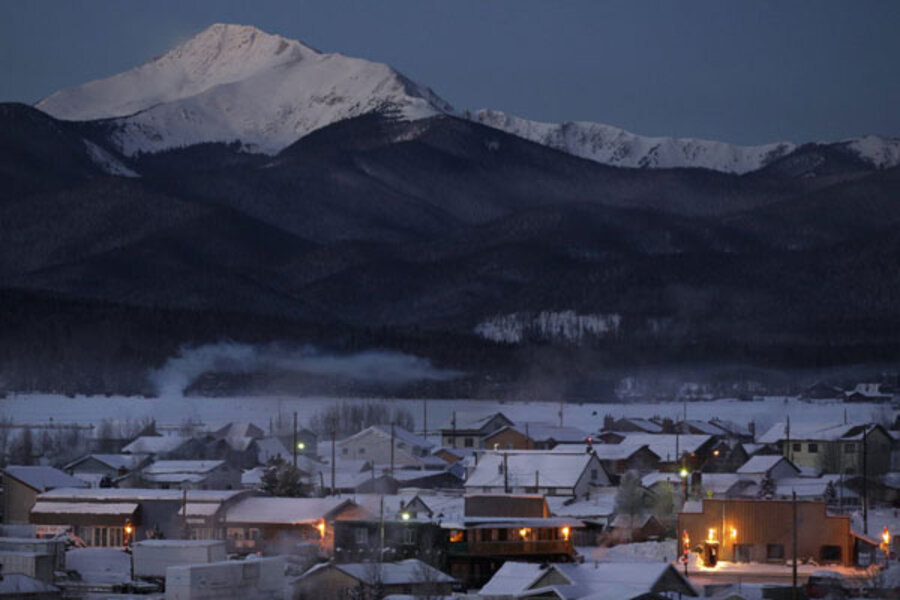Let it snow? Christmas may be white in Northeast, southern Plains, Seattle
Loading...
Most Christmas Day travelers will be able to get to Grandma’s house without needing to throw a set of tire chains in the trunk. But not everyone.
Residents of places like Oklahoma City and Tulsa, Okla., can expect six inches or more of the white stuff. Dallas may see a light dusting of snow. And St. Louis, which often misses the worst of the snow storms, may have to crank up the salt spreaders after all.
In the Northeast, meanwhile, a weak weather system may deliver a light coating of snow by Christmas morning to the suburbs of Philadelphia, New York, and even Boston. Roads are likely to be slick, but not impassable.
On the West Coast on Christmas Day, residents in the hilly suburbs of Seattle may also be scraping snow off their windshields. Through the day that snow will spread into the Cascade mountain range in Oregon and, perhaps, northern California.
The wintry weather on Christmas Day marks the beginning of a week that meteorologists predict will be wet, wild, and possibly white.
“The pattern is a stormy weather pattern for the week for a good chunk of the country,” says Tom Kines, a meteorologist at AccuWeather.com in State College, Pa.
People along the Gulf Coast from Houston to the panhandle of Florida need to be especially alert, he says. That area faces the potential for severe thunderstorms and, possibly, tornadoes. At the very least, residents there will get a lot of rain, as warm air from the Gulf of Mexico collides with the cold air to the north.
“Residents in those areas could have a very wet Christmas,” says Mr. Kines.
Storm systems racing across the country are likely to cause delays at some airports during the busiest travel days of the year. However, because most of the precipitation in the eastern US will be rain, the delays aren't expected to be too bad.
Moreover, the prospect of wet weather is not likely to adversely affect retailers who traditionally have one of their busiest days of the year on Dec. 26, when shoppers return gifts, cash in gift cards, or take advantage of sales, says some retail analysts.
“The good news is that people will still be able to get to the stores even if they are a little delayed,” says Evan Gold, a senior vice president at Planalytics, a business weather advisory firm in Berwyn, Pa. “For most people along the I-95 corridor, it will be rain, not snow.”
The area with the heaviest snow on Christmas Day is likely to be the southern Plains. A storm system will leave the Rocky Mountains this evening, and snow will begin to fall in the panhandle of Texas in places like Amarillo. By Christmas, Oklahoma City and then Tulsa will be battling blowing snow. Later in the day, the system will spread into the Ozarks, with some areas getting as many as six inches of snow.
The heavy white stuff that will hit the southern Plains on Tuesday will spread into the Ohio Valley on Wednesday. The greatest accumulations of snow will stretch from Indianapolis to Cleveland to Buffalo and Albany in upstate New York.
“In that slot, they could get six to 12 inches of snow or even more in some places,” says Kines.
Most of those cities are accustomed to handling a lot of snow, notes Mr. Gold. “Not only that, but they have tons of salt left over from last year when it barely snowed,” he says.
Some areas that normally get a lot of snow this time of year, such as Minnesota and Wisconsin, are not likely to see any with these systems. “Everything will be south of them,” says Kines.
On Sunday evening, the West Coast received a drenching rain. That stormy pattern is likely to continue, resulting in the snow in the Pacific Northwest. By Wednesday, Kines says, Los Angeles and San Diego will get some rain.
As that new system moves east, it could result in yet more snow and rain later in the week for other parts of the nation. However, it’s still too early to know if it will bring snow to the East, says Kines.
Looking ahead, Gold says the stormy pattern is likely to continue into January. However, the precipitation won't remain rain, but is likely to turn to snow in the east as temperatures fall. He views that as positive for merchants.
“Retailers will be able to clear out seasonal products such as cold-weather apparel and snowblowers,” he says. “Over the next few weeks, people will be buying based on need – and they will need winter coats and boots.”
Unlike last year when the ski resorts did not get much snow, this year will be different, Gold says. “This week if you planned to ski in Maine or Vermont, you picked a great time to go,” he says. “And if you plan on skiing in the Rockies or the mountains of California, it will be ideal. The ski resorts have been waiting for this.”







